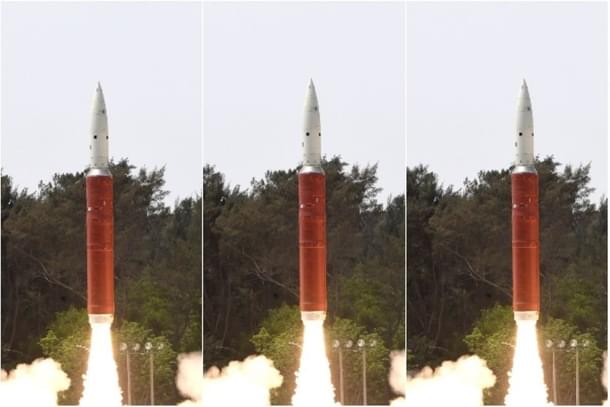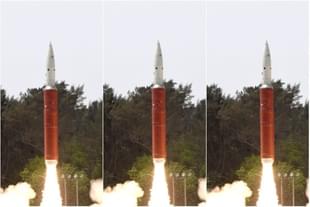Defence
Four Years Of A-SAT Test: India Needs Much More Than A Satellite Killer Missile To Deter China In Space
Prakhar Gupta
Mar 27, 2023, 02:26 PM | Updated 03:38 PM IST
Save & read from anywhere!
Bookmark stories for easy access on any device or the Swarajya app.


On this day four years ago, a Missile Defence interceptor, developed as part of India's ambitious Ballistic Missile Defence Programme, lifted off from Abdul Kalam Island, breathing out orange plume as it made its brief but majestic vertical ascent in the journey towards its target.
In under three minutes, the missile hit a live Indian satellite Microsat-R, located about 300 kilometers above the earth’s surface, and destroyed it kinetically — by the sheer impact of the collision.
India's first anti-satellite (A-SAT) test had been completed successfully, making it the third country in the world to demonstrate the capability.
Announcing the success of the A-SAT test in a televised address to the nation, Prime Minister Narendra Modi hinted that the new capability that India had acquired will deter adversaries from targeting its space-based assets.
He identified the utility of satellites in various fields, including military, and said that it was increasingly important to protect them.
To mark the test’s significance, PM Modi dubbed the A-SAT test as ‘Mission Shakti’, a moniker similar to the one given to India’s 1998 nuclear tests — Operation Shakti.
Although Modi did not identify any specific threat to India’s space-based assets and noted that the A-SAT test wasn’t directed towards any country, it was amply clear that the test was meant to deter China — Pakistan does not have the capability to threaten India’s satellites or the wherewithal to develop it.
China, however, had tested an A-SAT weapon in 2007, destroying a weather satellite at an altitude of over 850 kilometres.
The test, conducted at roughly the altitude used by the US and Japan for some of their imagery intelligence satellites, drew widespread criticism as it created around 35,000 pieces of debris larger than one centimetre, thousands of which — some as large as four inches — will continue to orbit the Earth at high speeds for decades.
With just one of India’s two adversaries armed with the capability of destroying its satellites in orbit, it is clear who New Delhi was trying to deter.
But how much of a deterrent is it, in reality?
The anti-satellite weapons used by China and India in 2007 and 2019, respectively, are categorized as direct-ascent kinetic interceptors in technical parlance. These weapons use ‘hit-to-kill’ technology developed primarily for application in ballistic missile defence systems.
Simply put, an interceptor which uses this technology hits and destroys its target with energy purely generated by its high speed.
When this method is employed to destroy a satellite in orbit, especially at high altitudes, a large part of the debris generated as a result remains lingering in space for decades, as seen in China’s case.
And debris in space is a real threat. In 2011, the crew of the International Space Station had to take refuge in escape capsules because of a piece of debris which passed within 1,100 feet of the station at a speed of over 45,000 km per hour.
In 2013, researchers say, a piece of debris left behind from China’s 2007 anti-satellite test hit a Russian satellite, reportedly changing its orientation and orbit.
Learning from the international opprobrium following its A-SAT test, China has been developing non-kinetic counter-space weapons which, unlike kinetic interceptors, do not generate debris. These include directed energy weapons, space-, air- and ground-based radio frequency jammers, high-power microwave systems, co-orbital A-SAT apparatus and offensive cyberspace capabilities.
Directed energy weapons (DEW), which the US Defense Intelligence Agency (DIA) says China is putting in place, can disrupt, degrade and destroy targets using a highly focused beam of energy, including low- and high-energy lasers and high-power microwave (HPM). DEWs can be used for results ranging from temporary to permanent.
These weapons are usually used to temporarily dazzle or permanently blind critical electro-optical or infrared sensors on satellites. High-powered lasers can also damage other parts of a satellite, including its solar arrays.
HPM weapons, which are most effective when deployed in air or space, are capable of disrupting electronics of a satellite and corrupting data stored in its memory.
These weapons can also be used to cause permanent damage to a satellite’s electrical circuits and processors when used at high power levels.
China hasn’t shied away from testing and flaunting these capabilities. In 2006, a year before its A-SAT test with a kinetic interceptor, China had employed high-power lasers to blind US’ satellites flying over its territory.
Soon after, the then director of the US’ National Reconnaissance Office, Donald Kerr, had acknowledged that US imagery satellites were dazzled while passing over Chinese territory.
In 2013, Chinese researchers revealed that the country had successfully conducted a “blinding experiment” against “a low orbit satellite with a tilt distance of 600 km” using a “50-100 KW capacity mounted laser gun” as early as 2005.
Over a decade later, China is likely to have much more sophisticated DEWs to target satellites.
According to DIA, Beijing may field a ground-based laser weapon capable of targeting low-orbit space-based sensors by the year 2020, and in the late 2020s put in place “higher-power systems” which can also target non-optical satellites.
But retired Indian Army Colonel Vinayak Bhat, a satellite imagery analyst who specializes on China, suggests that the country has already set up five DEW facilities, including one in the restive Xinjiang province. The operational status of these bases remains unknown.
Having acquired ground-based satellite jammers from Ukraine in the late 1990s, China has also made significant progress in the deployment of satellite jamming systems.
The DIA says that the People’s Liberation Army (PLA) routinely makes jamming and anti-jamming capabilities against communication, radar systems, and Global Positioning System satellite, part of its exercises, adding that it is now developing jammers to target synthetic-aperture radar on military reconnaissance platforms.
Radio frequency jammers can target an uplink (link from a ground station up to a satellite), downlink (link from a satellite down to ground stations and users) and cross-link (a communications link between two satellites), thereby blocking the transfer of data from satellites to ground stations, hampering latter’s control over former, and preventing co-ordination between two or more satellites required to work in tandem.
China has also been working on co-orbital systems with robotic arms, often referred to as ‘space stalkers’. These systems, using their robotic arms, can inflict damage on a satellite in orbit or change its trajectory without generating debris.
The first major evidence of China’s efforts to develop co-orbital anti-satellite systems emerged in 2010, when a Chinese satellite named Shijian-12 made a series of remote proximity manoeuvres to rendezvous with an older Chinese satellite SJ-6F.
The satellites are not only reported to have come within a few hundred meters of each other, but the former may also have made contact with the latter. Following this, anomalies were observed in SJ-6F’s orbit, fueling speculation.
In 2016, China launched atop a Long March 7 rocket, a satellite named Aolong-1, or Roaming Dragon, equipped with a robotic arm, which Chinese scientists said was a space-junk collector.
Launched in peacetime, such space assets can be employed to inflict limited damage on an adversory's satellites during crisis. If it can grab a relatively small piece of debris in space, reaching a satellite, much larger in size, should not be difficult.
China is also known to have developed a sophisticated cyber attack architecture, mostly under the PLA’s Strategic Support Force, and has demonstrated its ability to use this to target space assets in the past.
As early as 2007 and 2008, US Geological Survey’s Landsat-7, a remote sensing satellite in the polar sun-synchronous orbit, was targeted by cyber attacks believed to have originated from China.
National Aeronautics and Space Administration’s Terra Earth observation satellite is also believed to have been targeted by China in 2008.
In some cases, the hackers “achieved all steps required to command” the satellites but did not issue commands, which indicates that the attacks were meant to test and demonstrate China’s capabilities.
Armed with non-kinetic weapons, the effect produced by some of which are reversible and difficult to attribute, China is unlikely to use a debris-generating interceptor missile as the first means of attack on India’s space assets.
Moreover, given that its use of a kinetic interceptor would give India the excuse to respond using a similar weapon, China may not go down that road.
However, in the event of use of 'clean' weapons by Beijing against Indian satellites, India will have no comparable options. The only weapon at New Delhi’s disposal would be a debris-generating kinetic interceptor.
As China's fleet of military satellites is much larger than India’s, New Delhi would have to destroy a relatively larger number of Chinese space assets to attain its goal of denting Beijing’s capabilities significantly. And the more the satellites killed, the more the debris.
Will India exercise the option of killing a large number of Chinese satellites with an A-SAT interceptor in response to an attack on its space assets, creating a ring of rubble around the Earth in the process when China didn’t?
The unacceptably high and shared cost of exercising this option may deter India, and China would not think otherwise.
Thus, India’s kinetic A-SAT weapon provides only limited deterrence to New Delhi — it may deter Beijing from using its kinetic weapons against India’s space-based assets. It is not a deterrent against China’s ‘clean’ A-SAT weapons which do not generate debris in space.
Prakhar Gupta is a senior editor at Swarajya. He tweets @prakharkgupta.




